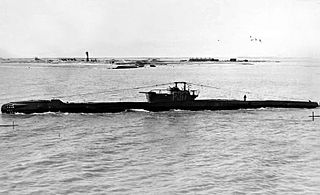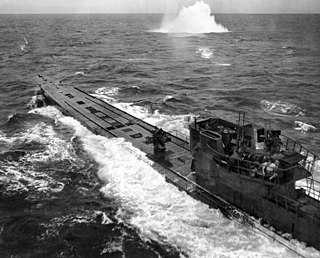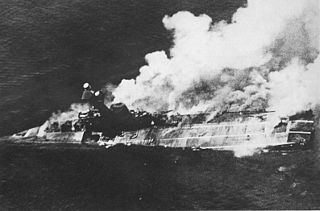German submarine U-862 was a Type IXD2 U-boat of Nazi Germany's Kriegsmarine during World War II. After Germany's surrender in May 1945, U-862 put into Singapore and was taken over by the Imperial Japanese Navy under the name I-502.

The Regia Marina (RM) or Royal Italian Navy was the navy of the Kingdom of Italy from 1861 to 1946. In 1946, with the birth of the Italian Republic, the Regia Marina changed its name to Marina Militare.
German submarine U-859 was a Type IXD2 U-boat built for Nazi Germany's Kriegsmarine during World War II. She was one of a select number of U-boats to join Monsun Gruppe or Monsoon Group, which operated in the Far East alongside the Imperial Japanese Navy.
German submarine U-181 was a Type IXD2 U-boat of Germany's Kriegsmarine during World War II. The submarine was laid down on 15 March 1941 at the DeSchiMAG AG Weser yard at Bremen as yard number 1021. She was launched on 30 December 1941 and commissioned on 9 May 1942 under the command of Kapitänleutnant Wolfgang Lüth. After training with the 4th U-boat Flotilla at Stettin, U-181 was attached to the 10th flotilla for front-line service on 1 October 1942, then transferred to the 12th flotilla on 1 November.
I-29, code-named Matsu, was a B1 type submarine of the Imperial Japanese Navy used during World War II on two secret missions with Germany. She was sunk while returning from the second mission.
German submarine U-140 was a Type IID U-boat of Nazi Germany's Kriegsmarine during World War II. She carried out three combat patrol. Built at the Kiel shipyards during 1939 and 1940, as a Type IID U-boat, she was too small for major operational work in the Atlantic Ocean, which was now required by the Kriegsmarine as the Battle of the Atlantic expanded.
Foreign U-boats was the title for a special section created by Nazi Germany's Kriegsmarine that adopted 13 captured enemy submarines and a single Turkish vessel into the U-boat corps. Beginning in 1939 and lasting until the end of World War II in 1945, the Kriegsmarine modified a total of 13 captured enemy submarines, then deployed them into combat with German crews. The special corps was not especially successful, as only ten enemy ships were destroyed by Foreign U-boats through the entire war. Eight of these were destroyed by UA, which was a modified Type IX U-boat originally built for the Turkish Navy. However, some were effective as minelayers.

A merchant submarine is a type of submarine intended for trade, and being without armaments, it is not considered a warship like most other types of submarines. The intended use would be blockade running, or to dive under Arctic ice.

The Marconi class was a class of six submarines built for the Royal Italian Navy. The submarines were all launched between 1939 and 1940, and all but one, Luigi Torelli, were lost in the Atlantic during the Second World War.
Michel(HSK-9) was an auxiliary cruiser of Nazi Germany's Kriegsmarine that operated as a merchant raider during World War II. Built by Danziger Werft in Danzig 1938/39 as the freighter Bielsko for the Polish Gdynia-America-Line (GAL), she was requisitioned by the Kriegsmarine at the outbreak of World War II and converted into the hospital ship Bonn. In the summer of 1941, she was converted into the auxiliary cruiser Michel, and was commissioned on 7 September 1941. Known as Schiff 28, her Royal Navy designation was Raider H. She was the last operative German raider of World War II.
HMS Porpoise (N14) was one of the six-ship class of Grampus-class mine-laying submarines of the Royal Navy. She was built at Vickers Armstrong, Barrow and launched 30 August 1932. She served in World War II in most of the naval theatres of the war, in home waters, the Mediterranean and the Far East. She was sunk with all hands by Japanese aircraft on 19 January 1945, and was the last Royal Navy submarine to be lost to enemy action.

HMS Tally-Ho was a British submarine of the third group of the T class. She was built as P317 by Vickers Armstrong, Barrow and launched on 23 December 1942. She has been the only ship of the Royal Navy to bear the name, that of the hunting call, "Tally-Ho!".

The Gruppe Monsun or Monsoon Group was a force of German U-boats (submarines) that operated in the Pacific and Indian Oceans during World War II. Although similar naming conventions were used for temporary groupings of submarines in the Atlantic, the longer duration of Indian Ocean patrols caused the name to be permanently associated with the relatively small number of U-boats operating out of Penang. After 1944, the U-boats of the Monsun Gruppe were operationally placed under the authority of the Southeast Asia U-boat Region.

Prior to World War II, the Indian Ocean was an important maritime trade route between European nations and their colonial territories in East Africa, the Arabian Peninsula, British India, Indochina, the East Indies (Indonesia), and Australia for a long time. Naval presence was dominated by the Royal Navy Eastern Fleet and the Royal Australian Navy as World War II began, with a major portion of the Royal Netherlands Navy operating in the Dutch East Indies and the Red Sea Flotilla of the Italian Regia Marina operating from Massawa.
Italian submarine Luigi Torelli was a Marconi-class submarine of the Italian navy during World War II. The vessel operated in the Atlantic from September 1940 until mid-1943, then was sent to the Far East. After Italy's surrender in 1943, the Luigi Torelli was taken over by Nazi Germany's Kriegsmarine, then, in the waning months of the war, the Japanese Imperial Navy. It was one of only two ships to serve in all three major Axis navies, the other being the Italian submarine Comandante Cappellini.

German submarine U-450 was a Type VIIC U-boat in the service of Nazi Germany during World War II.

The action of 11 January 1944 was a minor naval action that resulted in the sinking of the light cruiser Kuma of the Imperial Japanese Navy by the British Royal Navy submarine HMS Tally-Ho. Kuma was being escorted by the destroyer Uranami about 10 nmi north-west of Penang, Malaya.
Reginaldo Giuliani, better known as Father Giuliani, was a Dominican friar, a soldier and Italian writer.

The Liuzzi class was a class of four submarines built by Tosi in Taranto for the Royal Italian Navy. The submarines were built in 1939 and began their Second World War service in the Mediterranean Sea, where Liuzzi was sunk. The three surviving boats were transferred to the BETASOM Atlantic submarine base at Bordeaux in 1940. After Tarantini was sunk, Bagnolini and Giuliani were selected for conversion to "transport submarines" in order to exchange rare or irreplaceable trade goods with Japan. Cargo capacity of 160 tons reduced reserve buoyancy from between 20 and 25% to between 3.5 and 6%; and armament was reduced to defensive machine guns. The submarines saw action in the Second World War during which they collectively sunk 5 freighters and 1 light cruiser and were eventually either sunk or captured.

The Port of Penang is a deepwater seaport within the Malaysian state of Penang. It consists of terminals along the Penang Strait, including five in Seberang Perai and one in George Town. The Port of Penang was the third busiest harbour in Malaysia in terms of cargo as of 2017, handling 1.52 million TEUs of cargo, as well as the busiest port-of-call within the country for cruise shipping.











